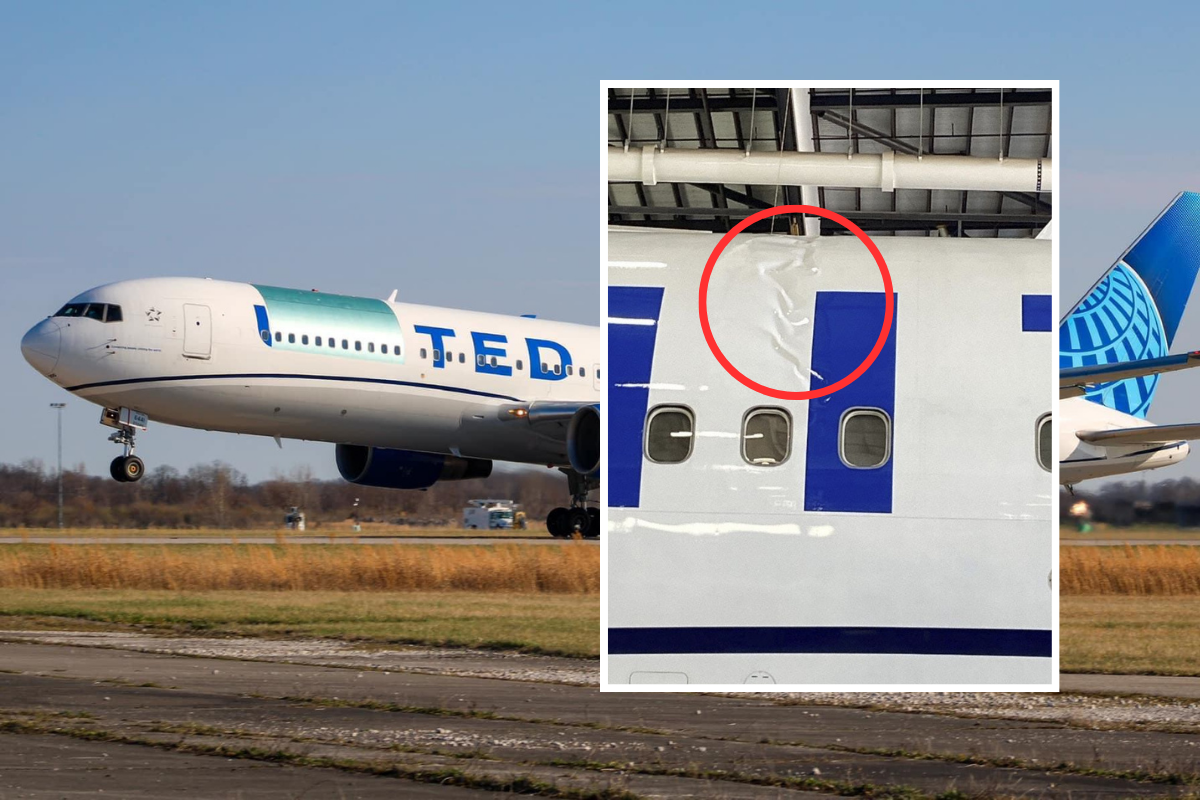
An ex-United Airlines pilot who was terminated by the Chicago-based carrier following an abnormal landing that left one of the airline’s aging fleet of Boeing 767s with such severe damage that it took seven months to be repaired is now suing the airline for defamation.
Romullo Silva filed his lawsuit against United Airlines earlier this week in a New Jersey district court, demanding damages of at least $100,000 over claims that the airline made false statements to the Federal Aviation Administration (FAA) in the aftermath of the accident.
The lawsuit stems from an incident on July 29, 2023, when Silva was the pilot flying a Boeing 767 from Newark to Houston Intercontinental Airport as flight UA702 with 193 passengers onboard.
According to a preliminary accident report by the National Transportation Safety Board (NTSB), as the aircraft landed, the nose wheel made contact with the runway with an “abnormal force” equivalent to a gravitational force of 1.4g.
The aircraft then bounced, and despite Silva’s attempts to stop the aircraft from impacting the runway with force for a second time, the nose gear again slammed into the tarmac with a gravitational force equivalent to around 1.6g.
There was then a second bounce, and the nosewheel once again impacted the runway for a third time – this time with a gravitational force of 1.6g.
A post-accident examination of the aircraft revealed what the NTSB described as “substantial damage to the upper crown of the fuselage,” with wrinkles and crumpling clearly visible along the body of the 33-year-old plane.
The damage was so bad that United had to immediately pull the airplane from service so that extensive repairs could be carried out, including inserting a new section of fuselage in the area that had been crimpled.
Having previously worked for United Airlines as a flight attendant, Silva joined the carrier as a First Officer just seven months before the accident.
In his lawsuit, Silva admits that he was the pilot flying the plane at the time of the accident but insinuates that the Captain was responsible for the unusual landing because he failed to arm the speed brake.
The fact that the speed brakes weren’t armed, Silva claims, was the reason that the nose gear “went down hard on the runway.”
Silva was pulled from duty the same day as the accident and wasn’t allowed to return to work until September 30, when he was first presented with the findings of a ‘flight safety investigation’ before being ordered into a simulator to test out his landing skills.
Without being given any opportunity to practice his skills after four months on the ground and only 113 hours of flight time on the Boeing 767, Silva says he found himself having a so-called ‘check ride’ in the simulator with a “hostile, degrading and intimidating” assessor.
Silva failed his check ride and less than two weeks later, United terminated his employment.
United then allegedly told the FAA that Silva was the ‘pilot in command’ of flight UA702, despite the fact that this role can only ever be assigned to the Captain. Silva believes that this ‘false statement’ has tarnished his FAA record and effectively made him unemployable as a pilot.
The lawsuit alleges that United Airlines deliberately made the false statement to the FAA in order to protect the Captain, who was on the flight deck with Silva at the time of the accident.
“United made this false statement in an effort to protect [the] Captain from any ramifications with the FAA,” the legal complaint alleges. “As a result of these false statements, Mr Silva has been severely damaged and cannot find employment as a pilot for any other carrier.”
Along with requesting substantial damages, Silva is also demanding an injunction against United to force them to retract their claim that he was the ‘pilot in command’ of flight UA702. Silva is also demanding attorney fees because United “has been stubbornly litigious.”
Related
Mateusz Maszczynski honed his skills as an international flight attendant at the most prominent airline in the Middle East and has been flying ever since... most recently for a well known European airline. Matt is passionate about the aviation industry and has become an expert in passenger experience and human-centric stories. Always keeping an ear close to the ground, Matt's industry insights, analysis and news coverage is frequently relied upon by some of the biggest names in journalism.








that’s crazy work! bending a plane and failing to perform in the sim is why he will not get hired, now add a lawsuit on top of that! on one will trust this FA to had out snacks let alone land a plane!
He was not the Captain he was a FO.. Both made a mistake not verifying all checks fo0r landing. But it is defamation to say he was the Capt and only put it on him Both should have been accountable and hope they look at having a software update to have a warning alarm under a certain approach / speed / alt
He was on probation with under a year at United. He failed a check ride BEFORE the accident, was given another chance and barely passed it. He was on a 3 month retest schedule as opposed to a 9 month because he was a poor pilot. He may not have passed his probation period without this accident. He was the pilot flying, not the captain, nobody said he was captain. . He damaged a multi-million dollar piece of equipment and took it out of service for seven months, and only with luck nobody was hurt. He deserved to lose his job.
He will not get another job as a pilot, and should not ever fly passengers again. Why? Because he is blaming others, will not accept responsibility and cannot handle pressure. Somebody would have hired him, although not the majors, if he had accepted his error, admitted it and learned from it. At this point, he should not even get a job as a flight attendant or ramp agent . Assuming this story is true, it is hard to believe.
The captain had been flying for United since 2001, passed his checkrides and has an excellent record. The speed brakes were not armed and the captain should have noticed but he did not cause the PIO and was the one who stopped it.
I hope this guy loses every penny. People who sue when they are clearly in the wrong are just looking for a settlement and companies need to stop giving in to these grifters.
Kinda spooky to think this aircraft is on the line out there still flying ? Would you trust that repair job, even year(s) later if it’s still in service ? Amazing what companies will do in the name of $$$.
The repaired area is going to be the strongest part of the aircraft because it is new.
Yes, we trust that certified mechanics and FAA oversight are doing their job. This isn’t Botswana, and without faith in our institutions and professionals then this country won’t function. Those engineers who repaired the aircraft are highly skilled, and millions of travelers put their faith in their professionalism every year.
Tell us more about how you don’t know anything about aircraft manufacturing or maintenance. I would have no problem getting on this aircraft and considering the number of 767’s I’ve been on lately, it wouldn’t surprise me if I already have.
The article says the accident happened on July 29th, and he was called in on September 30th and given a check ride, yet that’s only a couple days more than 2 months, not 4 months. Still, It would have been better if they gave him a couple of Sim sessions to “re-train”, and then a check ride.
Also, standard procedure if the speed brake does not deploy on touchdown is that the captain would manually deploy the speed brake. Wonder if this happened?
I’m left wondering if he touched down on the nose wheel first, as opposed to a normal landing on the main gear, which would explain the “porpoising”. Even if the speed rake is armed, it would not deploy on nose wheel. touchdown, only when the mains touch. Normal procedure in the event of a bounced landing is to go around immediately., not try to “ride it out’. This article leaves out some crucial details that may not have been available to the author at time of publication, but leaves many questions and not very many answers.
The Captain was neglegent did not verify all his FO was doing but he was the captain and nothing occurred to him/her as they need Capts.
It wasn’t a “check ride”. It was training. His characterization is a tool of a desperation. That’s what everyone claims when they fail to meet standards during training. Yes, every training session has “standards”. Don’t meet them, you don’t preogress…or in this case since you are already qualified, and on probation…you’re gone. Passengers will appreciate that.
https://www.youtube.com/watch?v=Cha9tePckoo
Main gear, gear bounced up, nosed pushed down, nose gear hit, main gear hit, nose hit 2 more times. Pilot induced oscillation problem. Not good, especially with the final report providing the documentation of the inputs and positions. But both failed a checklist time.
100%
I trust the mechanics that got this massive repair accomplished.
I’ve flown this aircraft a number of times since it’s been back on the line – first time was about two weeks after it was released for service. Needless to say, my preflight walk around was quite thorough. If I didn’t know it was “the one” I’d have had no idea. Amazing work that was done to repair the damage…
Yes I would. As a pilot I know the repairs are highly regulated and made with new parts. The repair is now the strongest part of that plane since all the other parts have decades of wear and teat on them.
Silva does as a Silva does
Umm… speedbrakes not deploying won’t make the pitch tendency down to be at a greater rate than usual… this guy should have never been on a jet in the first place it appears. He clearly hasn’t read the FTCM, nor has aerodynamics knowledge.
Spoilers armed tends to prevent the aircraft from bouncing in the first place. It would at the least reduce the severity of the bounce. That being said, I completely agree that it wouldn’t prevent a hard landing in the first place. It wouldn’t have prevent that first hard hit of the nose gear (might have even made it a little worse,) but could have prevented or reduced the severity of the subsequent ones.
Of course, it’s not like he couldn’t have looked over to verify that the spoilers were armed. And while it’s true that he wasn’t pilot-in-command (and I’m pretty much 100% certain that the FAA and any perspective employer knows that,) he was Pilot Flying. His unemployability doesn’t really sound like anyone’s fault but his own.
I dont know much, but apparently in these airplanes, but there is a de-rotate tendency that is harder with reversers deployed and no speed brake. From the article though, it seems the capt was not doing his part wither arming or deploying the speed brake.
It takes BOTH pilots to run a before landing checklist. Silva is just as complicit in this hard landing as the captain.
Exactly Both but the end all be all is the Capt not the FO. and no action against the Capt is the issue if both were handled the same it would no0t be an issue. But Capts are in high demand and are a major investment.. FO’s are to but not there yet
Not always. Some aircraft checklists are NOT CR (Challenge and Reply) checklists. Sometimes (depending on SOPs) this is the case for the Landing Checklist. In that case the pilot monitoring would run the checklist and the pilot flying would fly the aircraft without responding to the checklist commands. That being said, yes, the pilot flying should be aware of what the pilot monitoring is doing.
The speed brakes are activated by main gear spin up. Wirhout the mains touching down they will not deploy the f/o obliviously minimum time for experience. 7 month service put him on probation anyway
It’s not certain the Captain failed to arm the spoilers and regardless they are not required for landing. I virtually never armed the spoilers for landing until my company mode it mandatory. For the first 15 years the 767 was flying it was optional. The spoilers will come up with reverse thrust actuation. You could get much smoother landings with them unarmed.
It would be interesting to know the FO’s flight experience prior to flying the 767. His being a former FA at United it makes me wonder if they hired him with very little flight experience.
EASA does it completely different. We don’t have the 1500 hrs rule, we have pilots flying Airbus 320s 737s with 200hrs but we have excellent ground schools and 14 subjects that cant be compared to the four week study for the commercial pilot license theory of FAA. Also we have Multi Crew Cooperation and Jet Operations Transition Training that teaches you all the specifics, threats and techniques for getting your first step on a jet. 1500 hrs on single engine piston, another 1400 hrs on turboprops and 130hrs on the 767 doesn’t seem like a logical career progress. The point I’m trying to push is FAA ATP can be completed within a year without previous experience , EASA ATPL can be completed within at least 2,5 years with zero experience. Commander of the aircraft should have taken controls and initiate a go around. They’re both responsible for the accident
DEI hire
The F/O was the ” Pilot Flying”, the Capt was the “Pilot Monitoring”.
The NTSB report indicated that the FO was still on probation as he previously failed a check ride, then barely passed the next one. His issues included landings. As a member of the flying public, how he kept the job as long as he did is something I’d like to know more about.
Retired 747 Captain here. Sadly, we’re going to see a lot more of this in the future, with pilots of minimum experience being hired and then transitioning to the Captain’s seat in only a couple of years due to the massive retirements the industry will shortly experience. DEI will also rear its ugly head as well, with instructors pressured to pass students clearly not qualified in order to meet artificial quotas. Finally, NO minimum time new hire pilot should be assigned to a widebody aircraft without a minimum of 1000 hours experience on narrowbody types.